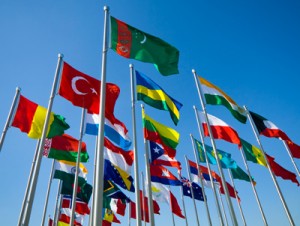Foreign Trade Careers Background
 Foreign trade is the exchange of goods and services between nations. It has been an important part of national economies for centuries, helping domestic industries grow to serve foreign customers and allowing people to enjoy goods produced outside their own country. The ingredients for two favorites in the United States, coffee and chocolate, for example, come from the warmer climates of South America and the Middle East, where coffee and cacao plants grow. Tobacco was first discovered in America and was grown and shipped back by the colonists. Spaghetti noodles were supposedly brought back from China by Marco Polo.
Foreign trade is the exchange of goods and services between nations. It has been an important part of national economies for centuries, helping domestic industries grow to serve foreign customers and allowing people to enjoy goods produced outside their own country. The ingredients for two favorites in the United States, coffee and chocolate, for example, come from the warmer climates of South America and the Middle East, where coffee and cacao plants grow. Tobacco was first discovered in America and was grown and shipped back by the colonists. Spaghetti noodles were supposedly brought back from China by Marco Polo.
Trade has always been a major force behind the relations among nations. While it has often helped create alliances among friendly trade partners, fights for control over raw materials or trade routes have also been the cause of wars throughout world history. International trade developed and has continued to be practiced by countries for two basic reasons. The first is that one country can supply something that another cannot produce. The other reason for international trade is cost. Although one country may be able to produce an item, it may be cheaper to make it somewhere else and have it brought in. Tea can be grown with some difficulty in a northern climate, but most tea for the world market is still supplied by India. India has a climate and soil well suited to the production of tea, and everything is in place to grow enough tea leaves to meet the demands of the world market.
With the establishment of standard trade routes and fairly stable governments in the Western countries, international trade became regulated and controlled by the 1700s. Taxes were levied against some import items to allow local producers to compete economically against foreign producers. (Import taxes are called tariffs.)
Trade limits were set on other items to keep the local market from being flooded with foreign goods. Europe traded with the United States from the time of the first settlements in the 1600s. As the American economy and industry expanded with the industrial revolution in the early 1800s, the variety of items the United States was able to trade with other countries increased greatly. After World War II, American international business quickly expanded its manufacturing and distribution facilities overseas. In some instances, these companies were established under licensing arrangements or as joint ventures with a foreign company.
A country’s balance of trade (relation of exports to imports) is an important measure of its economic health. Most economists believe that imports and exports should be equal in value, or exports should be higher, for a healthy national economy. When export shipments are smaller than imports, it means that money spent in other countries will not be returned. In the 1960s, the United States experienced an erosion of its dominant position in world trade, and in most of the years since 1970, it has reported a negative trade balance (more imports than exports). In 1999, the U.S. trade deficit reached an all-time high of $267 billion as economic crises in other countries caused our exports of everything from soybeans to automobiles to fall. No other developed nation has had such a large difference between exports and imports. Canada, Japan, and the European Union have all experienced an export growth greater than import growth. Because of this imbalance, the United States is keenly interested in expanding the export of American goods or controlling the import of foreign goods. Since that time, the trade deficit has continued to rise significantly, reaching $725.8 billion dollars.
Before the 1940s, the United States had a largely protectionist approach to foreign trade, meaning that the government enforced high tariffs and rigorous import restrictions to protect home market producers from overseas competition. Today, protectionism is not as popular as free trade, whose proponents favor open markets and economic interdependence. In a move toward more free trade, President Clinton signed two agreements in 1993. The North American Free Trade Agreement (NAFTA) is a pact among the United States, Canada, and Mexico. Its provisions include the elimination of all tariffs over the next 15 years on goods produced and sold in North America, the barring of governments from imposing special requirements on foreign investors, and the lifting of certain restrictions on services, such as banking, telecommunications, and transportation. The second pact, which consisted of amendments to the General Agreement on Tariffs and Trade (GATT), was approved by the U.S. Congress and the governments of 116 other nations. It reduces international trade barriers, including tariffs, import quotas, and export subsidies. Opponents of agreements of this sort argue that they put American jobs at risk and increase the U.S. trade deficit.
Today, advances in information technology have made the world a smaller place. It is quite easy for anyone, even in a remote area, to communicate with anyone else across the globe. This openness has created new markets all over the world. The growth of foreign business and its importance to the national economy has created a great need for individuals prepared to handle the complex problems of international business.